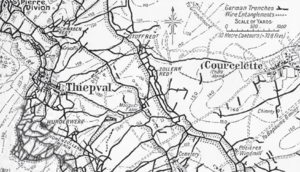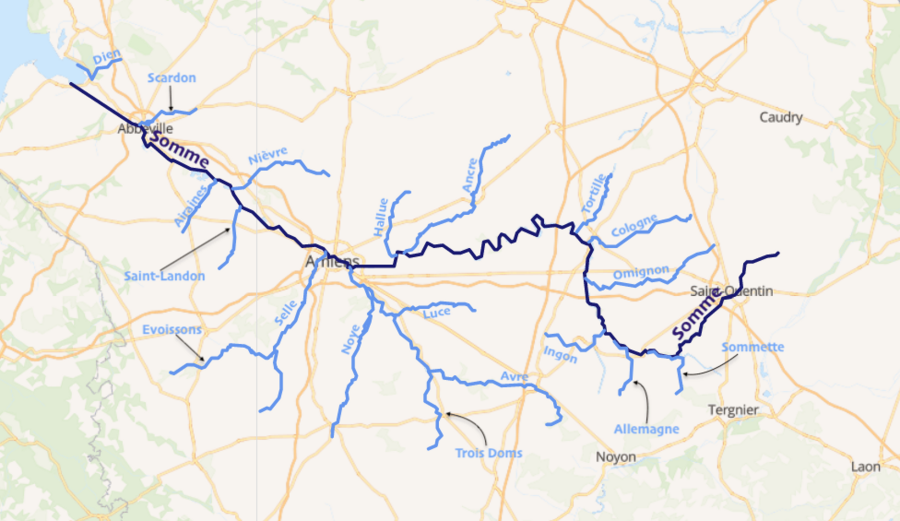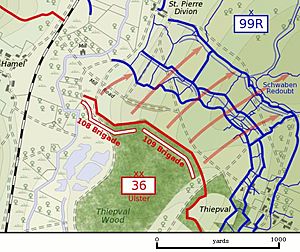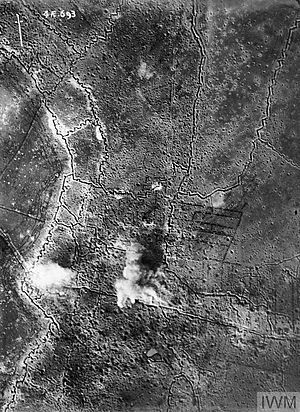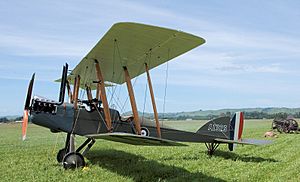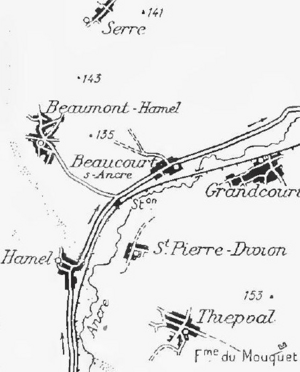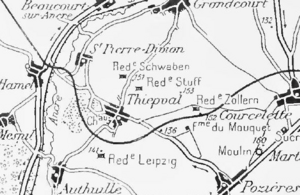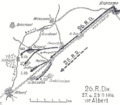Capture of Schwaben Redoubt facts for kids
Quick facts for kids Schwaben-Feste (Schwaben Redoubt) |
|||||||||
|---|---|---|---|---|---|---|---|---|---|
| Part of the Battle of the Somme of the First World War | |||||||||
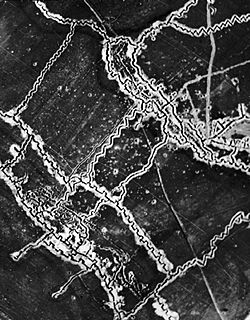 |
|||||||||
|
|||||||||
| Belligerents | |||||||||
| Commanders and leaders | |||||||||
| Douglas Haig Hubert Gough Joseph Joffre Ferdinand Foch |
Erich Ludendorff Kronprinz Rupprecht Fritz von Below |
||||||||
| Units involved | |||||||||
| Reserve Army/Fifth Army | 1st Army | ||||||||
| Strength | |||||||||
| parts of 4 divisions | |||||||||
The Capture of Schwaben Redoubt (Schwaben-Feste) was an important event during the Battle of the Somme in 1916. This battle was part of the First World War. A "redoubt" is a strong fort or defensive position. This German strong point was about 500 to 600 yards long and 200 yards wide.
It was built in stages starting in 1915. The redoubt was near the village of Thiepval in France. It overlooked the River Ancre. This area was part of the German defenses on the Western Front. The redoubt had many machine-gun nests, trenches, and underground shelters called dug-outs.
The German 26th Reserve Division from Swabia defended the redoubt. On 1 July 1916, troops from the 36th (Ulster) Division captured it. However, German artillery and counter-attacks forced them out after dark.
The British kept bombing the redoubt until 3 September. Then, the 49th (West Riding) Division attacked in a morning fog. They faced heavy German fire and counter-attacks. In late September, the British got a foothold in the redoubt during the Battle of Thiepval Ridge.
Attacks and counter-attacks continued until 14 October. On that day, soldiers from the 39th Division captured the last German part of the redoubt. They fought off German counter-attacks for several days. Today, the site of the redoubt is between the Thiepval Memorial and the Ulster Tower.
Background
Building Defenses, 1915
In January 1915, the German army decided to build strong defenses. This was to save soldiers while they fought on the Eastern Front. They made barbed-wire fences much wider, from 5–10 yards to 30 yards.
The front line of trenches grew from one to three. These trenches were about 150–200 yards apart. The first trench was for guards. The second held the main soldiers. The third was for backup troops.
Trenches were built with turns and concrete guard posts. Underground shelters, called dugouts, were made much deeper. They went from 6–9 feet down to 20–30 feet deep. Each dugout could hold about 25 men. An important line of strong points was also built about 1,000 yards behind the front line.
The Schwaben Redoubt
Behind the German front line, the ground rose steeply. This was the Thiepval ridge, about 250 feet higher than the Ancre valley. In early 1915, Germans began building trenches on this ridge. This network was called Schwaben Schanze (Swabian Fieldworks). It was about 700 meters north of Thiepval.
This position became the Schwaben-Feste (Schwaben Redoubt). It was connected to other key points like Mouquet Farm. The redoubt was very important because it overlooked Thiepval and the surrounding area. With other nearby strongholds, the Germans could see in all directions. They could also send soldiers to reinforce the front line or counter-attack.
The Schwaben Redoubt had deep dugouts for soldiers. It also had a command post, a first aid station, and a signaling station. It was armed with three heavy machine-guns and four light machine-guns. Many dugouts were at trench crossings. The redoubt was shaped like a triangle. It was about 500 meters wide at its front.
By July 1915, British soldiers were seen near Thiepval Wood. This showed that a British attack on the Somme front was likely. The Germans improved their defenses based on lessons from earlier battles.
Prelude to Battle
German Preparations
The Germans built even more defenses. They focused on the second and third lines, near the Schwaben and Grallsberg redoubts. New places for artillery were built. Dugouts were made deeper, and more exits were added. Engineers carefully planned and checked all the building work.
By July 1916, the German front line near Thiepval had sixteen rows of barbed wire. The second line had five rows. Dugouts were 30 feet deep and could protect all the soldiers in the trenches.
British Preparations
The British also prepared for the attack. In the area of X Corps at Thiepval, engineers dug special tunnels. These were called Russian saps. They allowed British soldiers to get very close to German lines before the attack.
The 36th (Ulster) Division had ten such tunnels. Each tunnel held two mortars (small cannons). The British planned a huge artillery bombardment. It would last for five days, but was extended to seven due to bad weather. Observers reported that the German barbed wire was well cut by the shelling.
The main attack would begin after a 65-minute "hurricane bombardment." Then, the artillery would move its fire forward in stages. This was to protect the advancing infantry. French artillery would also help by firing gas shells into the Ancre valley.
British Plan
The 36th (Ulster) Division's goal was to capture the fifth line of German trenches, called the D Line. The attack was divided into two main sections. The 109th Brigade would attack on the right. They would capture the first two German trench lines. Then they would move to the Grandcourt–Thiepval road.
The 108th Brigade would attack on the left. They would capture the first two lines and then dig in at the north-east corner of Schwaben Redoubt. The 107th Brigade would then attack the D Line. The attacking soldiers would advance in eight waves, 50 yards apart.
The Battle
1 July Attack
At 7:15 a.m., the Irish troops moved into no man's land. They were hidden by the bombardment and smoke. They got within 150 yards of the German front trench. At 7:30 a.m., the artillery fire stopped. The Irish advanced steadily. They crossed the first trench with few losses.
But then, German machine-gun fire hit the support troops. Fire from Thiepval cemetery and Beaucourt Redoubt caused many casualties. The leading soldiers pushed on. They reached the B Line by 7:48 a.m. They took many German prisoners.
However, German soldiers came out of dugouts behind the 108th Brigade. They had been missed by the "moppers-up" (soldiers clearing out remaining enemies). The leading waves kept going. They reached the C Line and the corner of Schwaben Redoubt by 8:48 a.m.
The German Reserve IR 99, defending north of Thiepval, was broken through. The attackers rushed Schwaben Redoubt around 8:00 a.m. The German defenders were surprised and surrendered quickly. About 500 Germans were taken prisoner.
The Irish advanced towards the Grandcourt Line. They ran into their own artillery fire. They then fell back to Schwaben Redoubt. German observers could not see the breakthrough because of smoke and dust. Only when the Irish advanced further did the Germans realize what was happening.
The 107th Brigade advanced to the A Line. But they faced heavy machine-gun fire from all sides. This caused many casualties. By 10:00 a.m., reports said the C Line had fallen. The attack on the D Line was supposed to start soon.
However, other British attacks on the flanks had failed. The commander of the 36th (Ulster) Division tried to stop the 107th Brigade's attack. But the order did not reach them. Telephone lines were cut, and messengers were shot.
The brigade advanced about 1,000 yards in a "wild and desperate venture." But German troops in the D Line pushed them back. German counter-attacks from St Pierre Divion were also pushed back.
By 10:00 a.m., the German front line was broken. This made Thiepval vulnerable to attack from the redoubt. The Germans ordered a counter-attack to retake the redoubt. But delays meant the counter-attack didn't start until 4:00 p.m.
British aircraft observed the battle. They reported that German artillery was moving back. Later, they saw no German troops gathering for a counter-attack.
British attempts to dig new trenches across no man's land failed. This meant supplies could not reach the front lines easily. German counter-attacks began. The 49th (West Riding) Division attacked Thiepval at 3:00 p.m. But they were stopped by heavy fire.
At 4:00 p.m., more British battalions were ordered to reinforce the Irish. But they were already fighting elsewhere. By 7:18 p.m., British attempts to advance were pushed back by machine-gun fire.
German troops advanced from Grandcourt. They moved along the ridge towards the redoubt. They overran some Irish positions. In the center, a German counter-attack was stopped by British artillery.
By 6:00 p.m., Germans had retaken some of their captured front line. They tried to rush the redoubt from the north but were pushed back. By 7:00 p.m., more German attacks on the redoubt failed.
At 9:00 p.m., German artillery began shelling the redoubt for an hour. German infantry attacked again, supported by fresh troops. In fierce hand-to-hand fighting, the Germans recaptured the redoubt in about thirty minutes. They found about 700 Irish dead soldiers. By midnight, the Germans had fully re-occupied the ridge.
3 September Attack
After 1 July, the British kept bombing the Thiepval area. This turned German defenses into ruins. On 3 September, the British attacked again along the Ancre river. The 49th (West Riding) Division attacked at 5:13 a.m.
They advanced behind a creeping artillery barrage. They suffered few casualties crossing no man's land. They took the German front line and reached the support trench. But they lost direction in the fog. German machine-gun fire swept through the British attackers. German battalions then counter-attacked with hand grenades.
The British on the left were caught by machine-gun fire. They failed to reach the German trenches. Visual signals failed in the mist. Few messengers got through the German shelling. By 7:30 a.m., the remaining British soldiers returned to their lines.
On the right, the British defended the German front trench. But they ran out of grenades and slowly retreated. A second attack was planned but then cancelled. The British battalions had lost over 1,200 soldiers.
28 September – 14 October
On 28 September, the 53rd Brigade attacked the area east of Schwaben Redoubt. They easily captured Bulgar Trench. They reached Zollern Trench by 1:15 p.m. But their advance towards the redoubt was stopped by heavy fire.
The 54th Brigade was to capture the west end of Thiepval. Then they would advance to Schwaben Redoubt. The attack on the redoubt was postponed. On 28 September, the 53rd Brigade attacked again. They easily captured Bulgar Trench. They got close to the redoubt by 2:30 p.m.
On the left, the 7th Queen's entered the southern face of the redoubt. They took fifty prisoners. They also captured the south-west corner. By 5:00 p.m., the entire south face was captured. British aircraft helped by directing artillery fire, destroying German gun positions.
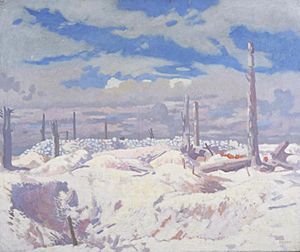
On 29 September, the British strengthened their positions in the redoubt. The 7th Queen's was replaced by other troops. The next day, the 8th East Surrey was counter-attacked. They were forced out of the redoubt but then retook it. However, the west face was lost.
At 4:00 p.m., the East Surreys attacked the northern face and took it. But the attack up the west face was pushed back. A German counter-attack at 9:00 p.m. forced the defenders of the north face back. On 2 October, the 55th Brigade in the redoubt was attacked. The fighting lasted all day.
Both sides continued fighting on 4 October, with no clear winner. The next day, the 8th Norfolks tried another attack. But the deep mud made movement difficult, and no ground was gained.
In early October, the 39th Division took over. German attacks from 7 to 8 October were supported by flamethrowers. But two British battalions pushed them back. On 14 October, the 4th/5th Black Watch, the 1st Cambridge, and the 17th King's Royal Rifle Corps attacked the north side of the redoubt.
The troops advanced and captured the last part of the redoubt by 11:00 p.m. They took about 150 German prisoners. Three German counter-attacks on 15 October, also with flamethrowers, were defeated. A German attack on 21 October was pushed back. A British attack that afternoon caught the Germans by surprise. British aircraft helped direct artillery fire to suppress German guns.
Aftermath
Casualties
On 1 July, the 36th (Ulster) Division had 5,104 casualties. The 49th (West Riding) Division had 590 casualties. By 19 August, the 49th Division's casualties had risen to 5,175. The attack on 3 September cost the 25th Division over 1,200 casualties.
The 18th (Eastern) Division lost 1,990 men during the capture of the redoubt. They estimated German casualties at 2,500, including 237 prisoners.
Images for kids


